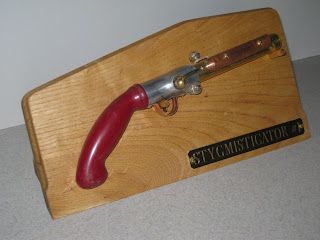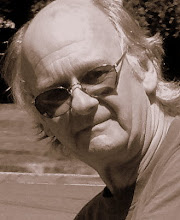
It's just about the rocker. But wait, if it's a rocking chair, that's it! It can't be just about the rocker if, when there's no rocker, it's just a chair!
There are three ways to bend wood: steam, kerfing, and bent lamination. Steam is very effective, fun to do, but limited to solid wood. (There is a new way of bending wood which involves compressing it endwise first to collapse the cells, but we'll get into that sometime in the future, when I'm smarter about it.)
Kerfing is the process of making numerous parallel saw cuts not clear through the board, evenly spaced, so the board can easily be bent but remain solid on one side. This often is used as a substrate for veneer, and the sides of the board--where the kerfing shows--is hidden.
Kerfing could conceivably work for making a rocker, but covering the kerfs and insuring enough strength would make it more labor-intensive than it needs to be.
Hence the bent laminations you see in the image. The bonus here is that you can include contrasting colors--something Sam enjoyed doing, and something that Charles encourages as a way to "have fun" and personalize your rocker. Coy's choice is maple, which brings a bright white to the walnut.
Right out of the clamping form, the stripes are even. When the rocker is rounded and shaped, these will be more expressive and artistic visual components.
Brock refers, in his written companion to the how-to DVD, to the "rockers' cyma curve" as one of the "most stunning features one usually notices about this chair."
Absolutely. But what is a "cyma curve"?
This is from Raymond McInnis' Online Dictionary of Woodworking:
The Queen Anne style emerged in England at the close of the seventeenth century. (Queen Anne -- the English monarch from Holland, i.e., the nation of the Dutch, but today called The Netherlands -- gave the "Queen Anne" style its name. She ascended the throne in 1702, and reigned until 1714.) The Queen Anne style is of Dutch inspiration, and as the historian of furniture history Joseph Aronson (pages 64-65) notes, "combines elements of comfort, grace, elegance". As the century progressed, in England the Queen Anne style evolved, and the cyma curve became strikingly more pronounced.
Aronson elaborates,
"Sleek and sophisticated, there is generally a unity of curved lines in Queen Anne furniture; a restraint of ornament and a better technical understanding of design. The cabriole leg is the outstanding detail, and its skillful association with other curves, as of seat outlines and back members of chairs, produces superb, distinctive designs. Improved technique made stretchers unnecessary after 1710, and pierced back splats became more decorative. Marquetry was subordinated to fine walnut surfaces. Carved motives were the scallop shell, broken and C-curves acanthus leaves."
Queen Anne style continued through the reign of George I and well into the reign of George II, so that late Queen Anne furniture often is called early Georgian. But says Aronson, -- The Encyclopedia of Furniture, New York: Crown, 1938, pages 64-65 -- "as the style progressed it had more and more curved lines. The cyma curve predominated".
A shorter explanation: the cyma curve is an elongated S.
There are things easily understood in a short time from a short sentence, and then there are things which require absorption and understanding. Reducing any significant furniture to references to geometric tropes would be, as they say, like dancing about architecture.
But it is good to zero in from time to time for a closeup.





